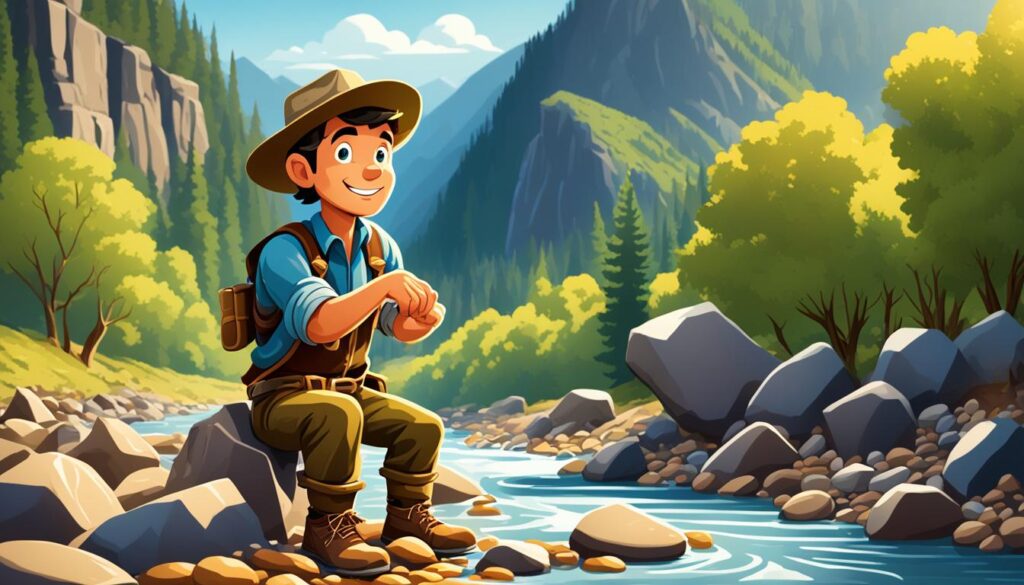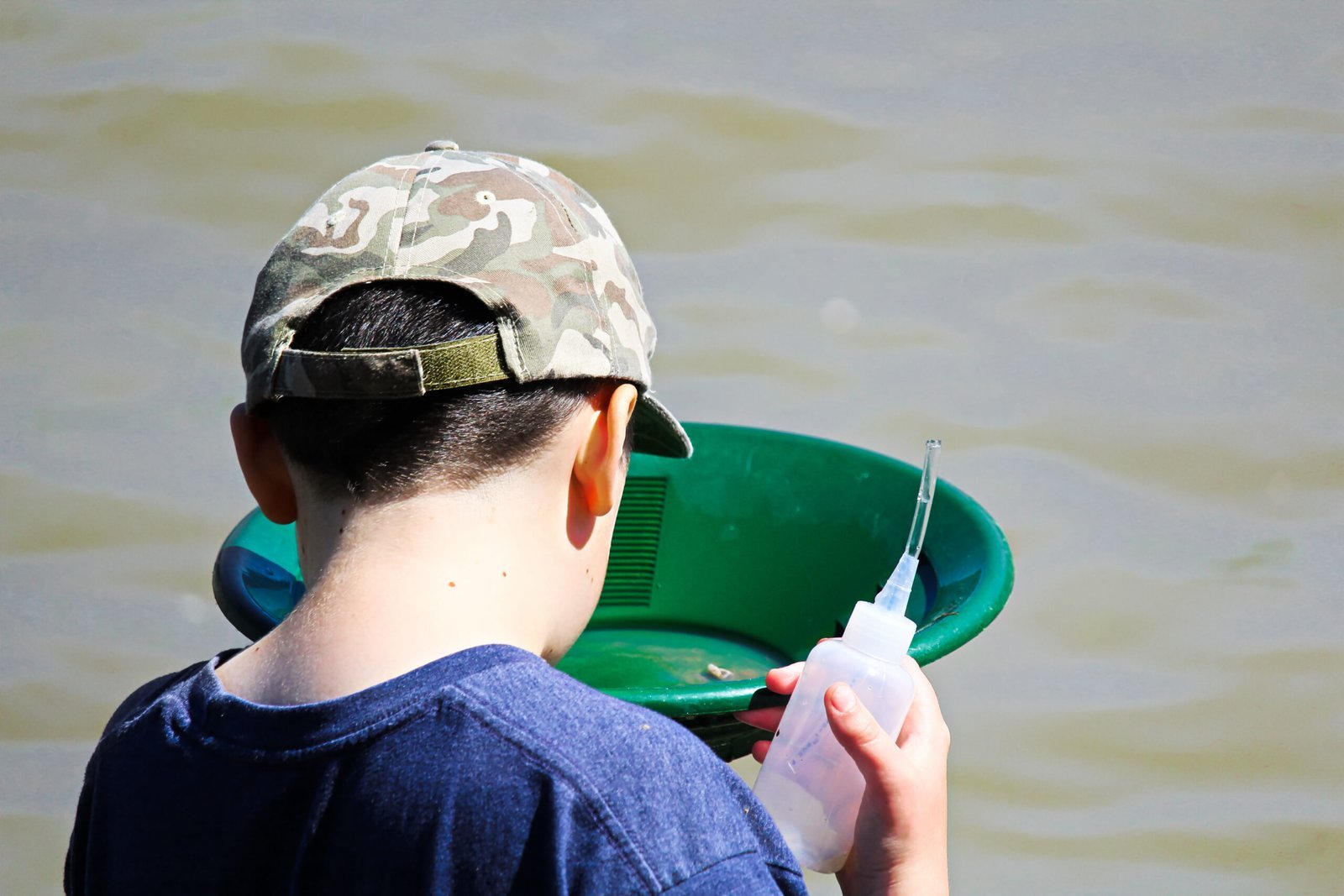Gold panning is a fun and educational activity for kids that combines adventure, history, and hands-on learning.
It allows children to ignite their curiosity and explore the outdoors while learning about geology and our natural environment.
The equipment needed for gold panning is simple and affordable, making it accessible to children of all ages.
By participating in purposeful gold panning education, kids can develop valuable skills such as problem-solving, patience, and observation, all while having a great time in nature.
Key Takeaways:
- Gold panning is a fun and educational activity that engages kids in hands-on learning about geology.
- It allows children to explore the outdoors, develop problem-solving and observation skills, and learn about our natural environment.
- The equipment needed for gold panning is affordable and accessible to children of all ages.
- Participating in purposeful gold panning education can ignite kids’ curiosity and foster a love for the outdoors.
- This educational activity offers a unique way for kids to learn about history, geology, and become stewards of the environment.
Equipment and Techniques for Gold Panning
When it comes to gold panning for children, having the right equipment and learning the necessary techniques is essential for a hands-on gold panning experience. Equipped with the proper tools and knowledge, kids can embark on an interactive gold panning adventure that sparks their curiosity and fosters a love for geology.
To begin their gold panning journey, children need basic equipment such as a gold pan, shovel, and water. These tools allow them to search for gold in rivers and creeks, putting their skills to the test. It’s important to emphasize safety and comfort during the activity, so kids should wear rubber boots, gloves, and a sun hat.
As kids gain more experience and develop a deeper interest in gold panning, they can explore advanced equipment that can enhance their gold panning lessons. Some of these tools include:
- Drywasher: A device that uses air to separate gold from lighter materials.
- Metal detector: An electronic device that detects metal, enabling kids to find hidden treasures.
- Highbanker: A portable sluice box that allows for more efficient gold recovery.
By learning different techniques and utilizing specialized equipment, children can refine their gold panning skills and increase their chances of finding gold. Whether it’s swirling the pan to separate heavy particles or using a drywasher to extract gold from the earth, interactive gold panning offers an engaging and educational experience for kids.
Incorporate the following table to highlight the various equipment and techniques for gold panning:
| Equipment | Function |
|---|---|
| Gold pan | The primary tool for collecting and separating gold from sediment. |
| Shovel | Used to dig and move soil and gravel during the gold panning process. |
| Water | Enables the sediment to be washed away, leaving behind heavy particles like gold. |
| Drywasher | Utilizes air to separate gold from lighter materials, improving efficiency. |
| Metal detector | Helps locate hidden metallic objects, including gold nuggets or flakes. |
| Highbanker | A portable sluice box that allows for greater gold recovery. |
By providing children with the right tools and teaching them effective techniques, gold panning becomes an exciting and educational activity that instills a sense of adventure and discovery. Engaging in gold panning lessons not only teaches kids about geology but also fosters a connection with nature and the wonders of the Earth.
Gold panning offers a unique opportunity for children to learn hands-on, combining excitement and educational value. With the right equipment and techniques, kids can unlock the secrets of gold and develop a lifelong love for geology.
Where to Find Gold
The key to successful gold panning is knowing where to look. Gold can be found in locations where it has been discovered before. Researching historical gold mining regions, consulting with local prospecting clubs, and using online resources such as government geology bulletins and gold mining reports can provide valuable information on where to prospect for gold.
Many public access areas, designated rockhounding or panning parks, and private mines offer opportunities for kids to pan for gold. Additionally, joining guided prospecting trips or visiting gold panning tours can provide a hands-on and educational experience for children.
Exploring these different options not only teaches kids about gold panning, but also allows them to engage in an exciting and interactive curriculum. It provides an opportunity for children to learn about the history of gold mining, the importance of preserving natural resources, and the value of patience and perseverance.
Gold vs. Fool’s Gold
When engaging in gold panning, it is crucial for kids to understand the difference between real gold and fool’s gold (iron pyrite). By learning how to distinguish between the two, children can enhance their gold panning skills and avoid disappointment.
Identifying Real Gold
Real gold possesses unique characteristics that set it apart from fool’s gold. Here are a few key points to remember:
- Weight: Real gold is heavier than fool’s gold. When swirling the pan with water, gold will be the last thing to move.
- Malleability: Compared to fool’s gold, real gold is more malleable. It can be easily shaped or bent.
- Purity: Placer gold, the type of gold commonly found in rivers and streams, is typically 18 karat or more pure. It has a distinct color, often described as a rich yellow or buttery hue.
Spotting Fool’s Gold
While fool’s gold may initially resemble real gold, it has distinct characteristics that can help kids identify it:
- Fractures: Fool’s gold tends to fracture at sharp angles, forming cubic or hexagonal shapes. Its crystalline structure sets it apart from the smooth texture of real gold.
- Weight and Color: Fool’s gold lacks the weight and color of real gold. It may appear lighter and have a brassy or pale yellow color.
Gold Panning Ethics and Reading Rivers
Teaching kids about gold panning ethics is essential for fostering a responsible and sustainable approach to the activity. Respecting mining claims on public land ensures that everyone can enjoy the thrill of gold prospecting while preserving natural resources. Moreover, instructing children on how to read a river can help them identify potential gold deposits. Understanding how rivers flow and the specific characteristics of gold-bearing streams can significantly improve their chances of finding real gold.
By instilling gold panning ethics and teaching kids to read a river, we not only enhance their skills but also deepen their appreciation for the activity and the environment in which it takes place.

Disclosure: This Post Contains Affiliate Links; We earn a commission on purchases.
| Real Gold | Fool’s Gold |
|---|---|
| Heavier | Lighter |
| More malleable | Less malleable |
| Typically 18 karat or more pure | Lacks purity |
| Distinct color (yellow) | Brassy or pale yellow color |
| Fractures at sharp angles |
Engaging in Gold Panning Education
Engaging kids in gold panning education can be an exciting and enriching experience. There are various activities and resources available that make learning about gold panning interactive and enjoyable for children. By incorporating educational materials, setting up gold panning areas, and participating in events and workshops, kids can develop a deep appreciation for geology and the natural environment.
One way to engage children in gold panning education is by setting up a mock gold panning area at home or in a school setting. This provides an interactive learning experience where kids can practice their skills and learn about the history of gold mining. By using pans, water, and sand, kids can simulate the process of searching for gold and understand the techniques used by prospectors in the past.
Another valuable resource for engaging kids in gold panning education is the incorporation of educational materials. Books and videos about gold panning can enhance their knowledge and understanding of the activity. These resources can provide information about the geology of gold deposits, the techniques used for gold panning, and the historical context of gold mining. By combining hands-on experience with educational materials, children can gain a comprehensive understanding of gold panning.
Participating in gold panning events and workshops is another excellent way to make gold panning education interactive and engaging. These events allow children to interact with experienced prospectors who can teach them valuable techniques and share their knowledge and expertise. By participating in group activities and demonstrations, kids can learn from real-life experiences and develop their gold panning skills.
| Educational Gold Panning Activities | Benefits |
|---|---|
| Setting up a mock gold panning area | Provides hands-on experience and simulates the gold panning process |
| Incorporating educational materials | Enhances knowledge and understanding of gold panning |
| Participating in gold panning events and workshops | Allows interaction with experienced prospectors and real-life learning experiences |
By making gold panning educational and engaging, children can develop a lifelong interest in geology and the natural environment. They will not only learn about the science behind gold panning but also develop valuable skills such as patience, observation, and problem-solving. Gold panning activities can ignite their curiosity, foster a love for the outdoors, and inspire them to become stewards of the environment.
Quote:
“Gold panning education provides children with hands-on learning experiences that foster a deep appreciation for geology and history. By engaging in interactive activities and utilizing educational resources, kids can develop valuable skills and knowledge while having fun in nature.” – John Smith, Experienced Prospector
Conclusion
Purposeful gold panning education provides a unique and exciting way for kids to learn about geology, history, and the natural world. Through hands-on experiences, kids can develop valuable skills and knowledge while having fun in nature. Whether it’s finding their first few flakes of gold or refining their gold panning techniques, gold prospecting with a purpose offers an adventure that combines entertainment and education.
By introducing children to the world of gold panning, we can ignite their curiosity, foster a love for the outdoors, and inspire them to become stewards of the environment. Engaging in purposeful gold panning education allows kids to explore the fascinating world of rocks, minerals, and the processes that shape our planet. It encourages critical thinking, problem-solving, and observation skills.
Additionally, gold panning provides a hands-on experience that brings history to life. Kids can learn about the Gold Rush and its impact on our country, as well as the techniques and tools used by Gold Rush miners. This interactive and educational activity not only provides a window into the past, but also teaches important lessons about perseverance, determination, and the value of hard work.
By combining entertainment and education, purposeful gold panning education offers a unique and engaging way for kids to learn about the natural world. It allows them to connect with nature, develop valuable skills, and gain a deeper appreciation for our environment. So, grab a gold pan, head outdoors, and embark on an adventure that will spark curiosity, create lasting memories, and inspire young prospectors to become lifelong learners in the world of geology and the great outdoors.
Source Links
- https://www.treelinereview.com/learn-skills/get-started-gold-prospecting
- https://goldrefiningforum.com/threads/calling-all-experienced-miners-and-prospectors.32553/
- https://www.icmj.com/magazine/article/seven-important-attitudes-for-the-successful-prospector-4557/

Meet Ryan Conlon, the passionate owner and driving force behind Pan for Treasure.
With an unwavering love for the art of gold panning, Ryan has transformed his enthusiasm into a thriving community hub for fellow treasure seekers. [email protected]
A seasoned gold panning enthusiast, Ryan’s journey began with a simple pan and a dream, evolving into a deep appreciation for the history, geology, and thrill of uncovering precious metals.
Subscribe to Our Newsletter

